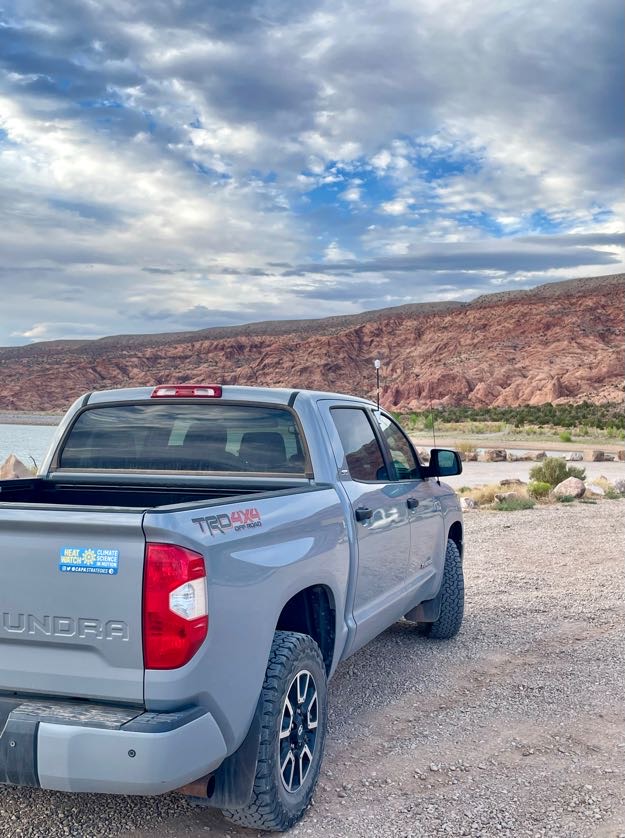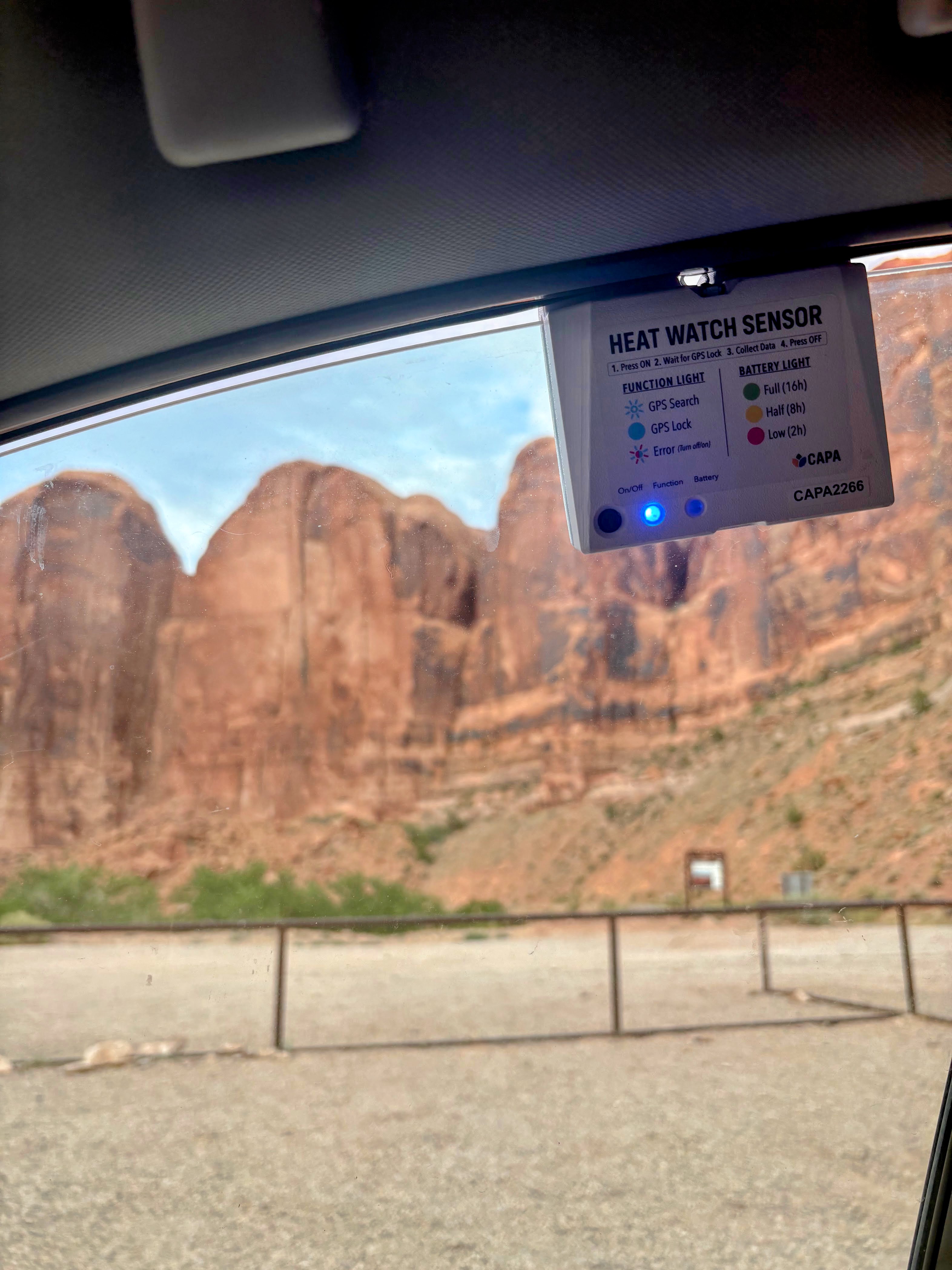Moab was selected to be part of a nationwide heat monitoring project.
We need your help collecting data. Volunteer!
How do we collect heat data?
🚘 A Heat Watch! On July 19th volunteers drove four Moab area routes during three designated periods in the day with a heat monitor on their vehicles. The data from the sensors will be processed and over the coming months, will provide the City and residents with a heat map to better understand where and when is the hottest in our region.


 Volunteer Sydney Maller near Swanny Park on July 19 sharing information and popsicles with children.
Volunteer Sydney Maller near Swanny Park on July 19 sharing information and popsicles with children.
Stationary Monitors! These will be mounted in the Moab Area and will collect temperature and humidity measurements for 12 weeks. More information on the CAPA Strategies website. See our 12 stationary monitor locations on the map.

Image Courtesy of CAPA Strategies

Long Term Monitoring! 2-year Multi-functional Sensors have been mounted at the Grand County Public Library; we have an indoor sensor and outdoor sensor to evaluate the effects of a cooling center. This sensor collects data for heat, humidity and air quality. The research team has installed sensors all over Utah. We will have a dashboard for data here soon!


Outdoor Sensor Indoor Sensor
🧰Volunteer as a Stationary Monitor Installer! Drivers will receive a mileage reimbursement.
📈Volunteer as a Stationary Monitor Data Collector! Volunteers will check on these sensors and download data 5 times in the 12-week period. Drivers will receive a mileage reimbursement.


Yes, we all know Moab is hot... So why are we doing this?
☀️ Because you asked us to!
When the City asked for your help building the Together Tomorrow Strategic Plan we heard you loud and clear that you want to the City to play a big role in helping mitigate the problems we face from extreme weather, including heat.
💡 Because it's efficient!
This is one part of a bigger, local heat study to learn what areas of town are most at risk. Once we know that, we can choose the most effective solutions to help protect locals and visitors from heat. Plus, anyone can use this heat map to help them make decisions: local healthcare providers, first responders, businesses, nonprofits, families -- you name it. Knowledge is power.
🏜 Because it's good for our economy!
Locals need to be safe and comfortable at home and at work. Visitors won't want to come to Moab if they aren't able to enjoy their time and feel safe in the heat. And, high-quality heat data helps us get grant funding to pay for solutions like increasing shade, upgrading cooling systems, and so on.
Dangers of Heat

A Few Solutions to Manage the Heat
Take a dip!

Moab Recreation and Aquatic Center Indoor Pool

Moab Recreation and Aquatic Center Outdoor Pool
Add shade!

Swanny Park Playground Shade Structure

Volunteers plant trees annually on Arbor Day
Other solutions are available, such as coatings to make pavements cooler and cooling centers that have power in an outage. Monitoring heat will help us learn which ones make sense in Moab.
We are grateful for all of our partners and volunteers!







Moab was selected to be part of a nationwide heat monitoring project.
We need your help collecting data. Volunteer!
How do we collect heat data?
🚘 A Heat Watch! On July 19th volunteers drove four Moab area routes during three designated periods in the day with a heat monitor on their vehicles. The data from the sensors will be processed and over the coming months, will provide the City and residents with a heat map to better understand where and when is the hottest in our region.


 Volunteer Sydney Maller near Swanny Park on July 19 sharing information and popsicles with children.
Volunteer Sydney Maller near Swanny Park on July 19 sharing information and popsicles with children.
Stationary Monitors! These will be mounted in the Moab Area and will collect temperature and humidity measurements for 12 weeks. More information on the CAPA Strategies website. See our 12 stationary monitor locations on the map.

Image Courtesy of CAPA Strategies

Long Term Monitoring! 2-year Multi-functional Sensors have been mounted at the Grand County Public Library; we have an indoor sensor and outdoor sensor to evaluate the effects of a cooling center. This sensor collects data for heat, humidity and air quality. The research team has installed sensors all over Utah. We will have a dashboard for data here soon!


Outdoor Sensor Indoor Sensor
🧰Volunteer as a Stationary Monitor Installer! Drivers will receive a mileage reimbursement.
📈Volunteer as a Stationary Monitor Data Collector! Volunteers will check on these sensors and download data 5 times in the 12-week period. Drivers will receive a mileage reimbursement.


Yes, we all know Moab is hot... So why are we doing this?
☀️ Because you asked us to!
When the City asked for your help building the Together Tomorrow Strategic Plan we heard you loud and clear that you want to the City to play a big role in helping mitigate the problems we face from extreme weather, including heat.
💡 Because it's efficient!
This is one part of a bigger, local heat study to learn what areas of town are most at risk. Once we know that, we can choose the most effective solutions to help protect locals and visitors from heat. Plus, anyone can use this heat map to help them make decisions: local healthcare providers, first responders, businesses, nonprofits, families -- you name it. Knowledge is power.
🏜 Because it's good for our economy!
Locals need to be safe and comfortable at home and at work. Visitors won't want to come to Moab if they aren't able to enjoy their time and feel safe in the heat. And, high-quality heat data helps us get grant funding to pay for solutions like increasing shade, upgrading cooling systems, and so on.
Dangers of Heat

A Few Solutions to Manage the Heat
Take a dip!

Moab Recreation and Aquatic Center Indoor Pool

Moab Recreation and Aquatic Center Outdoor Pool
Add shade!

Swanny Park Playground Shade Structure

Volunteers plant trees annually on Arbor Day
Other solutions are available, such as coatings to make pavements cooler and cooling centers that have power in an outage. Monitoring heat will help us learn which ones make sense in Moab.
We are grateful for all of our partners and volunteers!









 Volunteer Sydney Maller near Swanny Park on July 19 sharing information and popsicles with children.
Volunteer Sydney Maller near Swanny Park on July 19 sharing information and popsicles with children. 

















